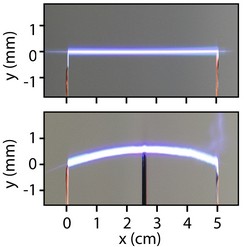Lasers tame unpredictable electrical discharges
Electrical discharges have found applications in welding, micromachining and fuel ignition, to name just a few examples. The tiny electrical spark that starts a combustion engine may look a lot different than lightning crackling through the sky, but they have something in common. They are both unpredictable. Lightning can be drawn towards a lightning conductor, however it has for a long time proved impossible to predict the path it will take to get there. When an electric spark is created, engineers hope it goes where they want it to go. However, EU-funded researchers have recently discovered a way to control the path of a spark as it arcs between electrodes. Technological advances and research carried out within the EU-funded KOHERENT (Kerr based OPA for high energy infrared pulse generation) project set the stage for a spectacular demonstration, where an electric spark followed a smooth path. Specifically, the researchers explored new routes for efficiently using mid-infrared pump lasers and producing long-wavelength radiation (up to 60 micrometres). Extensive investigations of photo-ionisation, induced in the air by the generation of long-wavelength radiation, allowed them to generate pulses that propagate on curved trajectories. For the demonstration, the researchers mixed and matched different types of laser beams. These were arranged by them so they could make an electric discharge move along a straight or parabolic trajectory. The path does not even have to be a simple one; it could follow curved trajectories, such as S-shaped ones. Light can be concentrated along a line, as within a Bessel beam, or along a parabola, as within an Airy beam. However, both Bessel and Airy beams have the ability to ‘self-heal’. If blocked, these laser beams can reconstruct themselves on the other side of the obstacle. The researchers wondered if this unusual beam property could be used for better guidance of electrical discharges. They placed an object between two electrodes and noticed how the electric discharge jumped over the ‘obstacle’ and made it to the next laser beam, without damaging the object. The discovery of how to make electrical discharges bend around curves was made at the ‘Advanced laser light source’ (ALLS) facility of Canada’s national scientific research institute (INRS). The researchers worked together with colleagues from Canada, China, France, the United Kingdom and the United States to achieve this breakthrough. Electric discharges have previously been used in industrial welding and machining, combustion engines and lightning-protection systems. Systematic and precise control of high-voltage discharges will open up an array of possibilities for both scientific research and applications.






